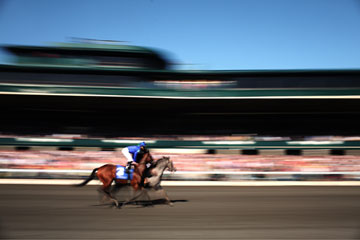
At Keeneland, a premier track in Lexington, Ky., the stakes can run to $750,000.
Correction Appended: May 6, 2013 and May 30, 2013
In the center Island of a sleepy cul-de-sac in my suburban Kansas City, Mo., neighborhood, a pair of huge stone markers stand in memory of two horses buried beneath the stones. lawrin, one stone announces solemnly. A darkly handsome Thoroughbred with matching white socks on his forelegs, Lawrin charged from the pack at Churchill Downs to win the 1938 Kentucky Derby by a length with a 22-year-old Eddie Arcaro on his back. Though Arcaro went on to become an international celebrity, the only jockey to win two Triple Crowns, he would go to his own grave saying Lawrin's run for the roses was the most thrilling ride of his career. Next to Lawrin lies his father Insco, who passed down the genes of his own pop, the great Sir Gallahad, one of four horses to sire three Derby winners.
Quite a lot of racing history to find planted so far from the shrines of Louisville, Santa Anita or Saratoga. This surviving remnant of the local Woolford Farm stables, where brilliant trainer Ben Jones served a stint on his way to the record books, recalls a time when America was still largely rural, most Americans knew something about horses, and racing was a truly national passion.
But the graveyard on Le Mans Court now says something about the endangered future of Thoroughbred racing. On May 4, the nation's fastest 3-year-olds will enter the starting gate for the 139th running of the spectacle at Churchill Downs. But while a huge crowd in Louisville and a vast TV audience marvel at two minutes of thundering excitement, elsewhere the sport of kings is struggling to avoid being buried--as Lawrin is buried under the march of suburbia--beneath inexorable forces of change.
Tracks are closing. Purses are dwindling. Fewer foals are being bred. Veteran breeders and trainers are hanging up their boots. Once privileged as the primary form of legal gambling in the U.S., horse racing now fights to be noticed in a gaudy arcade where strategy-minded punters choose among games from blackjack to Powerball to fantasy football. The arcane art of handicapping a pari-mutuel wager is downright tedious in an age of slot-feeding, card-scratching instant gratification. Very few Americans are raised on farms anymore; even fewer feel confident in their understanding of horses. And those who do know and love the animals are finding themselves turned off by the culture of doping in horse racing and the frequent breakdowns that go with it. Add a massive recession and the near paralysis of racing's many-headed management structure, and a once robust pastime is now scrabbling for a future.
As Dan Singer of McKinsey & Co. reported to the Jockey Club--the venerable protectors of the Thoroughbred breed--after completing a head-to-hoof examination of the industry in 2011: "Handle is down 37% ... attendance is down 30%, starts per horse and race days are both down 14%." "By any measure," Singer noted, "Thoroughbred racing has declined over the last decade," primarily because of "a failure to innovate fast enough and well enough to compete for new fans." Unless things change significantly, the situation will get much worse over the next decade, McKinsey projects, as horse owners see an already expensive sport submerged in a sea of red ink, while 1 in 4 tracks will be forced to close.
